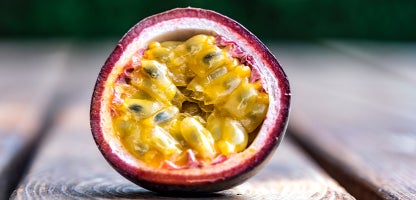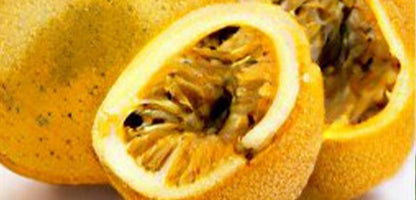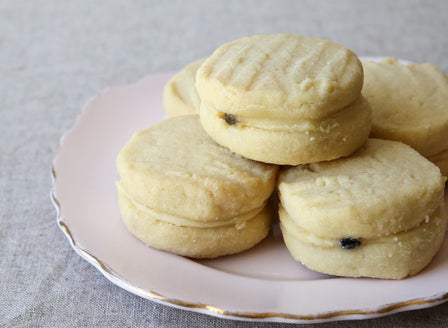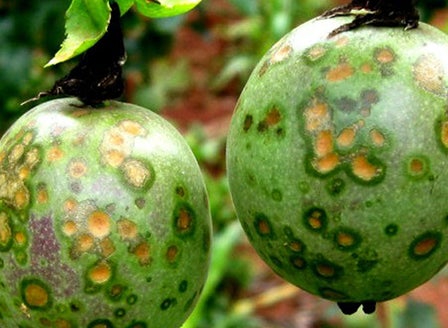A tropical lush green climbing plant that produces and abundance of red, orange or yellow skinned, sweet and sour delectable juicy fruit. Passionfruit is a vigorous, climber that clings by curly tendrils to almost any support. Growing very quickly under good conditions it can reach up to six meters in one year. The flowers on passionfruit are fragrant and are produced on new seasons growth. Passionfruit flowers are stunning, unusual and very tropical all designed to attract pollinators.
Planting Calendar
Passionfruit are best planted from October through till May.
Harvest In
12 - 18 Months
Passionfruit harvest times are between February to June and plants will start to bear fruit about 18 months after planting. After fruit start to appear, it will take them around two to three months to ripen. When fruit turn their respective colour and fall off the vine when shaken, this is the time to harvest them.
Prepare
Position
Passionfruit do best in a sunny sheltered position with plenty of space to grow. In areas that are particularly hot plant your passionfruit in partial shade. Provide a strong frame or support for your passionfruit to climb along.
Soil
When planted into the ground Passionfruit likes a moist but free draining soil that is rich in organic matter. To improve the organic content in your soil, break up the soil and add Kings Compost and Kings Sheep Pellets then mix together well. When growing in containers, plant into Kings Container mix. This mix contains added water storage crystals and Saturaid, two products that help maintain moisture in the soil.
Pollination
Pollination is carried out by bees and other insects. To encourage bees in your area, plant-pollinator plants including lavender, cosmos, echinacea, sunflowers or borage.
Plant
When planting into the ground, gently tap the plant out of its pot. Dig a hole twice the depth and width of the plants root ball. Mix Kings Compost into your existing soil at a 50/50 ratio, add Sheep Pellets and Kings Citrus and Fruit Tree Fertiliser, then mix together well. Back fill the hole with this soil, so that when planted the top of the plant’s roots sit level with the surrounding ground. Firm the soil down gently and water in well with Aquaticus Organic Garden Booster. In heavier clay soils, where drainage is likely to be an issue, plant onto a raised mound and sprinkle Gypsum Clay Breaker into the bottom of the hole, this helps slowly condition the soil and will help to break down the clay. When planting into containers plant in Kings Containers mix, as this has water retention crystals in it, which will help in keeping the soil moist. Firm the soil down gently and water in well with Aquaticus Organic Garden Booster.
Care
Watering
Keep plants well watered through the drier months. Deeply watering 3 times a week is more effective than a slight sprinkle every day. Water slowly allowing the water to sink down into the roots, rather than allowing it to run off the top of the soils surface. Add Saturaid into the soil at planting as this will help channel the water deep down into the root zone. If planted in pots never allow the pot to sit in water. When watering avoid wetting the foliage, and if possible, water in the morning.
Feeding
When planted in the ground liquid feed every month with Aquaticus Garden Booster, from Spring through to the end of Autumn, this encourages root growth and increases the microbial activity in the soil. Monthly applications of Kings Sheep Pellets will help with soil conditioning and plant health. In addition apply applications of Kings Citrus & Fruit tree food as per the instructions. If planted into a containers feed with Kings Slow Release Citrus Fertiliser along with monthly applications of Aquaticus Organic Garden Booster this encourages strong roots and a healthy immune system.
Protecting
Fungal problems thrive in damp, humid conditions, and plants are more susceptible if they are water stressed. Proper watering is essential. Protect from any chance of frosts by covering with frost cloth during winter.
Mulching
Mulch around the base of the plants (make sure that the mulch does not come into direct contact with the stem of the plant) with Living Earth More than Mulch. Mulching helps to reduce weeds as well as aiding the soil to retain moisture.
Spraying
Passionfruit are susceptible to fungal conditions and insect pests. Fungal conditions can be treated by applications GroSafe Free Flo Copper. Spray with Aquaticus Bugtrol for insect pests.
Pruning
By encouraging your passionfruit to stay fairly open you increase the airflow around the plant (which reduces humidity and the likelihood of diseases). Do this by pinching or cutting out denser growth. The fruit itself is formed on this season’s wood. So to improve fruiting, prune in early spring and in general it’s worth pruning one lateral hard each year. To stop your passionfruit vine from getting too big, pinch out the tips when it gets to the size you want.
General Care
When using sprays, chemicals or fertilisers always read the label and follow the instructions. Apply sprays in the evening to avoid harming beneficial insects.
Beginner Tip
When spraying, either spray first thing in the morning or in the evening when bees are not foraging. Avoid spraying in direct sun and onto flowers.
Expert Tip
Small crop numbers, or unripe fruit falling off the vine This is most likely due to poor pollination. Take care not to spray passionfruit flowers when treating your plant for pests or disease. Poor weather such as drought can also interfere. Keep them well watered over the summer.
Tip
For pest and disease information check out our Plant Doctor site on our website.
Top Varieties

Black Beauty
The most popular variety of passionfruit available, these evergreen vines produce masses of tangy purple-skinned fruit with golden centres.

Golden Passionfruit
Vigorous-growing evergreen vine with fruit slightly larger than the Black Beauty variety and more tropical, yet still hardy. Fruit is yellow on the outside and golden in the inside.
Frequently Asked Questions
Why is fruit falling off the vine before it is ripe?
This is most likely due to poor pollination. Take care not to spray passionfruit flowers when treating your plant for pests or disease. Poor weather such as drought can also interfere. Keep them well watered over the summer. Mulch well with straw, bark or More Than Mulch. To encourage bees in your area, plant-pollinator plants including lavender, cosmos, echinacea and sunflowers.
Where is the best place to grow passionfruit?
Passionfruit needs a good amount of space to grow and likes to have plenty of sun. Some protection from strong winds is also ideal. Provide them with moist soil that is rich in organic matter.
My Passionfruit has round brown spots on the fruit, what is it?
Oil spot is a common fungal condition that can affect passionfruit. This can be treated by spraying with GroSafe Free Flo Copper. Take care to apply as per the instruction's.
What are the small brown moths on it, what are they and what do I do?
This little moth is called Passion Vine Hopper, due to its ability to hop away when disturbed. The juveniles have a tuft of white fluff which makes them easily distinguishable. These can be treated by spraying with Bugtrol.

